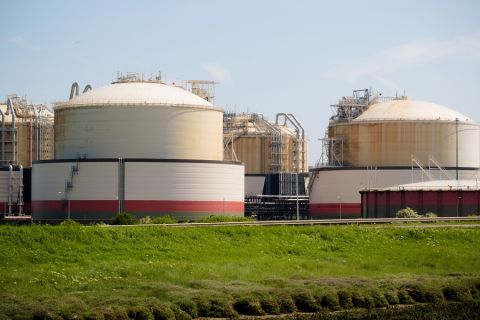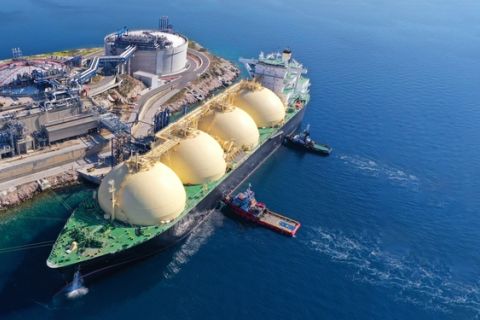The Big Bend (32/14) oil development in the deepwater Gulf of Mexico (GoM) began production on Oct. 26, Noble Energy said.
The single-well field is ramping up as expected and will likely produce about 20 Mboe/d max over the next few weeks, the company said. About 90% of the volumes being produced are oil.
The Dantzler development is being accelerated, and first production from it is now expected by early November, the company added.
Big Bend and Dantzler, located in Mississippi Canyon 698 and 782, respectively, are subsea tiebacks to the third-party Thunder Hawk production facility. Combined, the fields are thought to contribute 20 Mboe/d max net, to Noble’s production rate.
Inpex has completed the offshore pipelay for its 890-km, 42-in. diameter gas export pipeline for the Ichthys (32/15) LNG project. Work began in June 2014.
The company said the export pipeline is the longest subsea pipeline in the southern hemisphere and the third longest subsea pipeline in the world. The gas export pipeline will deliver gas from the Ichthys gas-condensate field to the onshore facilities at Bladin Point near Darwin for processing.
“Completion of the offshore pipelay marks a significant milestone for the project,” Managing Director of the Ichthys Project Louis Bon said. “It means we are one step closer to physically connecting our onshore plant near Darwin to the Ichthys Field where our offshore facilities will be permanently moored for the 40-year life of the project.”
The pipeline was installed by Saipem’s Semac and Castorone barges from Darwin to the Ichthys Field.
Inpex will conduct other necessary work on the pipeline in preparation for operational startup.
From Houston (BN): Shell development around its Perdido (32/14) hub continues. Shell has won approval of its plan to drill two 150-day to 200-day subsea wells and install trees, jumpers and umbilicals at Silvertip (32/15).
The project is in Alaminos Canyon blocks 815 and 859, in 2,850 m water depth about 240 km east of Brownsville, Texas.
Statoil isn’t letting Shell keep Power Nap to itself. Regulators have approved a project that one Statoil filing dubs Power Nap 2.
The Norwegian company plans two sidetracks from a well in Mississippi Canyon 942 to bottomholes just southwest of Shell’s late 2014 Power Nap discovery in MC 943.
Statoil’s 53-day sidetracks, in 1,280 m water depth about 240 km south-southeast of New Orleans, will curve into MC 986 and MC 987.
Statoil’s filing said it is targeting 27°API oil, similar in gravity to the 28°API oil Shell’s Power Nap listed in its filing.
Statoil is 100% owner of its blocks. Shell and Freeport McMoRan are 50:50 partners in MC 943, with Shell operating.
The area is crowded with activity. Power Nap is bracketed by the Shell-operated Vito (32/01) discovery, just to the southwest in MC 984, and Shell’s producing Crosby Field, just to the northeast in MC 899. Statoil is not alone even in MC 942. Bennu Oil & Gas has operating rights in the block down to 5,486 m to run its Morgus Field.
Bennu’s Titan hub is in MC 941 and serves Morgus, Mirage in MC 940 and Telemark in nearby Atwater Valley 63. It’s no wonder elbows are flying.
BP has agreed to speed up development of the recent Atoll (32/01) gas discovery in the North Damietta Offshore Concession in the East Nile Delta, offshore Egypt.
The agreement is expected to enable first production to be expedited from an estimated 42 Bcm of gas resources and 31 MMbbl of condensate in the Atoll Field to the domestic market, with production anticipated to begin in 2018.
Full field development of Atoll is expected to consist of two phases. Phase 1 will consist of two development wells tied back to existing infrastructure, with production expected to start up in 2018. Success of Phase 1 is expected to trigger additional investment and further wells to increase production.
Development of Atoll will be executed and operated by Pharaonic Petroleum Co., BP’s joint venture with EGAS and Eni.
BP Group CEO Bob Dudley said, “We are pleased to be making rapid progress towards the development of Atoll less than eight months after the announcement of its discovery. This is further demonstration of our continued confidence in Egypt—a key growth area for BP—and our commitment to continue to invest to unlock its energy potential.”
From Houston (BN): The government of Newfoundland and Labrador has announced plans for a generic oil royalty regime for offshore projects.
Assuming final approval in early 2016, it will replace the old system of negotiating royalties project by project.
The new system comes as Statoil considers development of its deepwater Bay du Nord discovery, and reports indicate the system was influenced by Norway’s royalty regime.
Under the new Newfoundland-Labrador system, developed after a study of systems worldwide with the help of Wood Mackenzie, the basic royalty at the start of a project’s production will be 1% rising to 7.5% of gross revenue as project costs are recovered.
Once project costs are recovered, rates will climb from 10% to 50% of net revenue as profitability improves. The highest rates will apply to projects that have returned $3 for every $1 spent on development.
Pemex recorded its 12th quarterly loss in a row, almost $10 billion for the third quarter, nearly triple last year’s third-quarter loss. Most of the blame went to declining world oil prices. The average price of Mexican crude exports was $41.75 per barrel during the quarter, half the $92 recorded in third-quarter 2014.
From Houston (BN): Just weeks after Petrobras touted record daily presalt production, the company faces a strike that is cutting output.
It reported a record 1.12 MMboe/d of presalt production on Sept. 15, as presalt accounts for a growing share of 2.5 MMboe/d in total output.
But on the first day of the strike, Petrobras said total output fell sharply—273 Mbbl/d for oil (13% of output) and 7.2 MMcm/d for gas (14% of output).
Petrobras said it is taking measures to maintain operations, preserve installations and protect workers, but it expects declines in production to persist pending a settlement and return to normal operations. The oil workers union, FUP, said Petrobras is understating the strike’s impact. Workers are striking to protest against sales of assets, and the company is planning to reduce its huge debt load.
The workers complain the asset sales will lead to job cuts.
Meanwhile, adding to the turmoil that has plagued Petrobras as a result of the Carwash bribery-kickback scandal and falling oil prices, Petrobras’ acting chairman, Clovis Torres Jr., resigned for what were described as personal reasons.
The Norwegian Petroleum Directorate (NPD) is pressing for unmanned wellhead platforms to be considered more often as an alternative to subsea tiebacks in connection with development decisions.
The NPD said a new study will look into the benefits and disadvantages of wellhead platforms, which have been dubbed “subsea on a stick.”
The study into the different types of unmanned wellhead platforms will be carried out by Rambøll Oil & Gas and will be submitted to the authorities towards the end of December.
“The main argument in favour of unmanned wellhead platforms as a concept is that this could be an efficient development solution in terms of both cost and production. In fact, it is just as functional and robust as a subsea development, and it is also more accessible for inspection and maintenance,” said Niels Erik Hald, principal engineer in the NPD.
Poland’s Lotos has snapped up a 15% stake in the Sleipner East (31/16), Sleipner West and Gungne oraz Loke oil and gas fields on the Norwegian Continental Shelf.
Lotos also has taken a 28% stake in the Alfa Central deposit, currently under development and expected to begin production in 2020.
The deal is worth an estimated $160 million, with an additional payment of $25 million for Alfa Central pending the Norwegian regulator’s approval of the field’s development plan.
Alfa Central is a 60-MMboe gas and condensate field, which is planned to be developed as a tieback to the existing infrastructure for Sleipner.
From Australia (LB): Malaysian firm Sona Petroleum has struck a deal to buy the Stag oil field off Western Australia from Santos and Quadrant Energy for $50 million.
Under the proposed acquisition, Sona will acquire a 100% stake in production licence WA-15-L and pipeline licence WA-6-PL in the Stag oil field.
Sona Petroleum said it intended to undertake further development of the oil field to enhance production, which will involve drilling of infill production wells.
“The Stag oil field has potential development and exploration opportunities and therefore, in a single transaction, Sona Petroleum will be able to enter the production, development and exploration stages of the upstream value chain,” Sona Petroleum said.
The Quadrant-operated Stag oil field, which has been in production since 1998, is located in the Dampier sub-basin of the Carnarvon Basin in water depth of about 50 m.
Centrica has entered into long-term partnership agreements with three suppliers to push forward its Butch (32/15) development off Norway.
Butch is being developed as a subsea tieback to BP’s Ula (32/15) platform in the Norwegian North Sea.
Centrica said the agreements are based on a strategic partner alliance (SPA) model covering all phases of project execution, with duration of up to 10 years.
The first call-off will be for FEED for Butch.
The SPAs have been agreed with Aibel, Subsea 7 and DNV GL. The objective is to establish a long-term relationship between Centrica and the suppliers to create value and predictability.
Aibel will deliver design, engineering and fabrication, Subsea 7 will provide pipelines, umbilicals and subsea service, while DNV GL will verify the work done.
Proserv has picked up a contract worth about $1.6 million to provide topside control equipment on the Johan Sverdrup Field off Norway.
Proserv will supply Aibel, on behalf of Statoil, with a hydraulic power unit and three chemical-injection panels to be used on the drilling platform.
Wood Group has scooped a new multimillion dollar contract to provide engineering services to BP’s existing subsea infrastructure in the Gulf of Mexico, U.K., Norwegian continental shelves and offshore Azerbaijan.
Wood Group Kenny (WGK) will deliver programme, project and integrity management and operational support for subsea projects under the five-year contract, which is effective immediately.
The contract will be delivered from WGK’s offices in Aberdeen, London, Norway, Houston and Baku and adds to WGK’s work with BP globally.
WGK continues to perform work under a contract held since March 2007 to provide engineering and project management services to BP’s portfolio of future subsea projects.
Balltec Engineered Solutions recently teamed up with Aker Solutions and Statoil for the design and manufacture of a unique lifting and handling solution that played a key part in the installation of the world’s first underwater gas compression plant at Åsgard (32/15).
The Balltec lifting solution was used for the deployment of five different subsea module designs of various differing weights and sizes.
Balltec’s scope of work was to design a flexible connector solution able to pick up the modules and land them on the seabed.
The connectors were designed as part of an engineered lift and were used to connect the modules and a lifting frame to accommodate the complex load parameters.
KBR has picked up detailed design engineering and follow-on services work from SMOE in Singapore for the topsides facilities for Maersk Oil’s Culzean (32/12) project in the U.K. North Sea.
Specifically, KBR will deliver the living quarters, central processing facility and wellhead decks for the three platforms for the Culzean project.
The heavy-lift vessel Jumbo Vision has transported subsea pump modules for McDermott from the OneSubsea facility in Horsoy, Norway, to Ingleside, Texas.
The cargo consisted of several modules, with a maximum cargo lift weight of nearly 350 mt, which will be installed in the deepwater Julia (30/08) Field in the Gulf of Mexico.
McDermott has an engineering, procurement and construction contract for the subsea infrastructure on the project in 2,170 m of water in Walker Ridge 584, about 375 km southwest of New Orleans.
Recommended Reading
Texas LNG Export Plant Signs Additional Offtake Deal With EQT
2024-04-23 - Glenfarne Group LLC's proposed Texas LNG export plant in Brownsville has signed an additional tolling agreement with EQT Corp. to provide natural gas liquefaction services of an additional 1.5 mtpa over 20 years.
Venture Global, Grain LNG Ink Deal to Provide LNG to UK
2024-02-05 - Under the agreement, Venture Global will have the ability to access 3 million tonnes per annum of LNG storage and regasification capacity at the Isle of Grain LNG terminal.
Shipping Traffic Freezes Up in Port Waters After Baltimore Bridge Collapse
2024-03-26 - U.S. port of Baltimore traffic was suspended until further notice following a bridge collapse. At least 13 vessels expected to load coal were anchored near the port at the time of the incident.
NextDecade Targets Second Half of 2024 for Phase 2 FID at Rio Grande LNG
2024-03-13 - NextDecade updated its progress on Phase 1 of the Rio Grande LNG facility and said it is targeting a final investment decision on two additional trains in the second half of 2024.
New Fortress Starts Barcarena LNG Terminal Operations in Brazil
2024-03-01 - New Fortress’ facility consists of an offshore terminal and an FSRU that will supply LNG to several customers.



